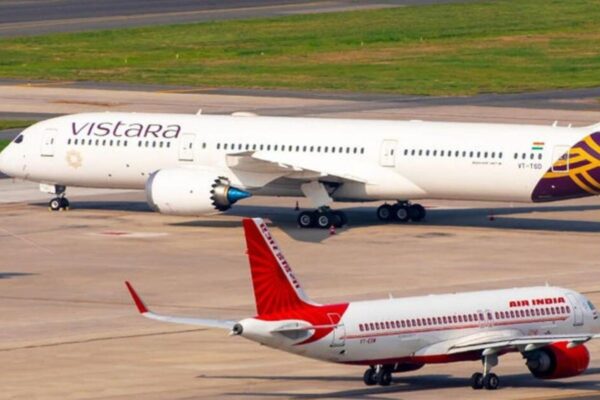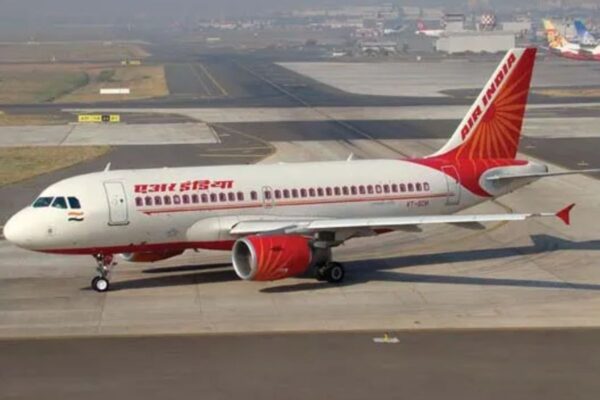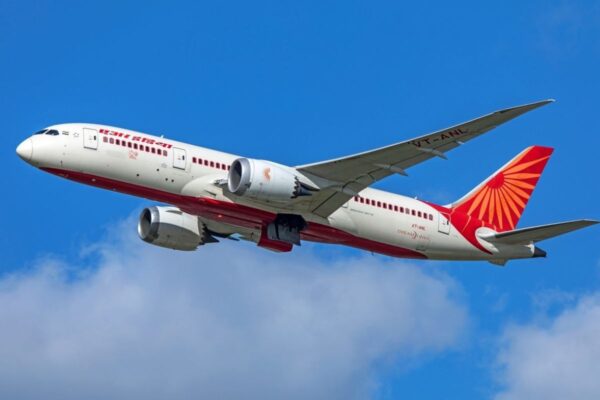Air India and Vistara Airlines will be combined by the Indian Tata Group

Air India and Vistara Airlines will be combined by the Indian Tata Group.
To create a larger full-service airline that will increase its footprint in both local and international skies, the Indian conglomerate Tata Group is merging Air India with Vistara, its joint venture with Singapore Airlines (SIA). The Indian company stated in a statement on Tuesday that car-to-steel behemoth Tata will own 74.9 per cent of the combined company and SIA the remaining 25.1 per cent.
According to Tata, SIA will contribute $252 million to Air India as part of the agreement, and the two companies plan to integrate by March 2024, pending regulatory permission.
According to Natarajan Chandrasekaran, chairman of the Tata Group, the merger was an essential step in attempting to change Air India into a “world-class airline.”
According to Chandrasekaran, “Air India is focusing on extending both its network and fleet, redesigning its consumer proposition, and improving safety, dependability, and on-time performance.”
The collaboration will strengthen SIA’s position in one of the aviation industry’s fastest-growing sectors and offer it a stronger competitor to India’s top carrier, IndiGo. SIA currently lacks a domestic flying market.

The largest passenger airline in India is IndiGo, a low-cost carrier established in 2006 with a market share of 56.7% as of October. The full-service Air India and low-cost Air India Express, which are being amalgamated with AirAsia India after Tata acquired former partner AirAsia, would be the centre of the Indian conglomerate’s brand consolidation.
Air India is the second-largest domestic and international airline in India.
In order to finance expansion and operations over the next two financial years, SIA said it and Tata had decided to take part in additional capital injections into Air India.
According to its 25.1 per cent post-completion stake, which becomes payable when the merger is complete, SIA might spend up to $615 million. It also stated that it will finance the plans using internal cash resources.
Goh Choon Phong, chief executive of SIA, said, “We will work together to support Air India’s transformation program, unlock its immense potential, and return it to its position as a premier airline on the world stage.
With a combined market share of 24 per cent in India after the merger, the new company will be a more formidable challenger to IndiGo, which has a 56 per cent market share, as well as full-service Middle Eastern rivals that handle a sizable portion of foreign traffic.

With 218 aircraft, divided between Boeing and Airbus, Tata would have the largest foreign airline in India and the second-largest local airline. In September, Air India announced that it would lease 30 Boeing and Airbus aircraft, more than doubling its fleet size in the next years.
According to sources in the industry, it is also thinking about placing a mega-order for up to 300 narrow-body and 70 wide-body planes. Its Maharaja mascot is well-known. JRD Tata launched Air India in 1932, which operates flights to all of the top international locations in North America, Europe, Asia, Australia, and the Middle East. The government seized control of the airline in 1953.
The largest automaker in the nation, the largest private steel company, and a top outsourcing company are all part of the enormous conglomerate of approximately 100 Indian companies. More than 350,000 individuals work for companies globally.
On September 25, 2014, Vistara received its first aircraft in New Delhi.
The last of the airline’s thirteen original Airbus A320 aircraft, which it received in October 2016, is one of seven Airbus A320neo aircraft it expects to receive by the middle of 2018.
Phee Teik Yeoh stated in March 2015 that the airline intended to purchase an unknown quantity of both narrow-body and wide-body aircraft in order to expand its local network and begin operating international routes within two years. Following its grounding, Vistara added nine ex-Jet Airways Boeing 737-800NG to its fleet.
Two of these aircraft were returned by Vistara in January 2020, while the remaining seven, which are on long-term leases, will leave the fleet between 2022 and 2023. Six Boeing 787-9 planes are on a standing order for Vistara, and they should arrive between 2020 and 2021. These Dreamliners were delivered in pairs, the first in February 2020 and the second in August 2020.
By the end of 2023, the airline, which presently has 50 aircraft, hopes to have 70, after accounting for some aircraft that will be returned to lessors.
Unprofitable routes are dropped from Air India’s domestic network.

The new management of Air India appears to be placing a high premium on network optimization as the carrier has reportedly made various adjustments to its domestic flight operations. Air India has eliminated a number of unprofitable domestic routes under the Tatas and is currently concentrating more on metro-to-metro connectivity.
Dropped Air India is attempting to clean up its network by eliminating numerous domestic routes that were incurring losses. Business Standard reported that the airline is expanding its presence on metro-to-metro flights while decreasing it on several non-metro sectors where it competes with multiple low-cost carriers.
Delhi-Ranchi, Delhi-Raipur, Delhi-Nagpur, Aizawl-Imphal, Bhopal-Pune, Kolkata-Dibrugarh, Kolkata-Dimapur, and Kolkata-Jaipur are among the routes that have been removed off the carrier’s network map.
Air India struggled with poor demand in a number of these sectors, and fierce rivalry prevented it from turning a profit in others. In accordance with the article’s data from Cirium, Air India ran 14 weekly flights in June that competed with IndiGo’s 58 and Go First’s 14 on the Delhi-Nagpur route. Air India operates 14 flights per week between Delhi and Raipur, compared to 62 for IndiGo and 28 for Vistara.
Pay attention to metros: A document from Air India that Business Standard was able to obtain states that the airline was focusing on “network optimization.”
These changes have increased frequency on some significant airport routes, including as Delhi-Mumbai, Delhi-Bengaluru, Mumbai-Chennai, Mumbai-Bengaluru, and Hyderabad-Mumbai.
Additionally, Air India has an advantage over other airlines like IndiGo and Go First because they operate fewer flights in some sectors because of the grounded aircraft.
According to a report by Ameya Joshi, an aviation analyst:
“The profitability of an airline is determined by the sum of its profitable routes. It always makes more sense to have a strong presence on metro routes as opposed to a weak presence on numerous routes. Metro-to-metro travel, which draws frequent customers and has a high volume, will be given preference by an FSC (full-service carrier) over attempts to enter new markets or hold onto failing ones.”
In fact, an Air India spokesman stated that the airline benefits from metro routes because it is easier to fill up premium cabins in these sectors. Under its new CEO, Campbell Wilson, other routes like Delhi-Amritsar, Delhi-Ahmedabad, Delhi-Lucknow, Delhi-Pune, and Kolkata-Guwahati have experienced an increase in frequency.
global expansion.
By starting up several previously abandoned routes to Europe and expanding its operations to North America, the airline is also focusing on its international service.
Prior to COVID, it had resumed service on lines from New Delhi to Milan, Copenhagen, and Vienna. Additionally, new Air India routes are starting to connect Mumbai with Frankfurt, New York, and Paris.
Using Boeing 777-200LR aircraft, a new daily Mumbai-New York service will launch on February 14th, 2023. It will complement Air India’s existing four weekly flights to Newark Liberty airport and daily service between Delhi and John F. Kennedy International Airport in the New York area. The airline now operates 47 nonstop flights a week between India and the US.
In addition, five Boeing 777-200LRs that were previously used by Delta Air Lines will soon be delivered to Air India. Air India will require roughly 100 pilots with the required education and experience to fly these wide bodies, and it is currently looking for talent abroad.
Edited by Prakriti Arora






